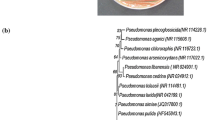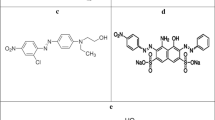Abstract
Laccase is an exothermic enzyme with copper in its structure and has an important role in biodegradation by providing oxidation of phenolic compounds and aromatic amines and decomposing lignin. The aim of this study is to reach maximum laccase enzyme activity with minimum cost and energy through optimization studies of Proteusmirabilis isolated from treatment sludge of a textile factory. In order to increase the laccase enzyme activities of the isolates, medium and culture conditions were optimized with the study of carbon (Glucose, Fructose, Sodium Acetate, Carboxymethylcellulose, Xylose) and nitrogen sources (Potassium nitrate, Yeast Extract, Peptone From Soybean, Bacteriological Peptone), incubation time, pH, temperature and Copper(II) sulfate concentration then according to the results obtained. Response Surface Method (RSM) was performed on six different variables with three level. According to the data obtained from the RSM, the maximum laccase enzyme activity is reached at pH 7.77, temperature 30.03oC, 0.5 g/L CuSO4, 0.5 g/L fructose and 0.082 g/L yeast extract conditions. After all, the laccase activity increased 2.7 times. As a result, laccase activity of P. mirabilis can be increased by optimization studies. The information obtained as a result of the literature studies is that the laccase enzymes produced in laboratory and industrial scale are costly and their amounts are low. This study is important in terms of obtaining more laccase activity from P.mirabilis with less cost and energy.







Similar content being viewed by others
Data availability
-.
References
Robinson PK (2015) Enzymes: principles and biotechnological applications. Essays Biochem 59:1. https://doi.org/10.1042/bse0590001
Çevik A (2017) Bacillus sp. determination of optimum ph and temperature values of the laccase enzyme that have been recognized. Dissertation, University of Kahramanmaraş Sütçü Imam
Altıntaş B Removal of textile dyes from artificial waste water using enyzme laccase. Dissertation, Gazi University [4], Rodriguez S, (2018) Solid-state fermentation for laccases production and their applications, In Current Developments in Biotechnology and Bioengineering, Elsevier: 211–234., Sarabia LA, Ortiz MC, Sanchez MS (2011) (2020) Response Surface Methodology: 287–326
Bozoğlu C (2014) Purification of laccase enzyme of thermophilic Brevibacillus sp. isolated from Agri Diyadin hot spring and determination of potential industrial usage of the enzyme. Dissertation, University of Atatürk
Rezaei S, Shahverdi AR, Faramarzi MA (2017) Isolation, one-step affinity purification, and characterization of a polyextremotolerant laccase from the halophilic bacterium Aquisalibacillus elongatus and its application in the delignification of sugar beet pulp. Bioresour Technol 67–75. https://doi.org/10.1016/j.biortech.2017.01.036
Olukanni OD, Osuntoki AA et al (2010) l Decolorization and biodegradation of Reactive Blue 13 by Proteus mirabilis LAG. Journal of Hazardous Materials, 184(1–3), 290–298. https://doi.org/10.1016/j.jhazmat.2010.08.035
Coker C, Poore CA, Li X, Mobley HL (2000) Pathogenesis of Proteus mirabilisurinary tract infection. Microbes Infect 2(12):1497–1505. https://doi.org/10.1016/S1286-4579(00)01304-6
Akyıl MH (2021) Investigation of contact-dependent inhibition (CDI) mechanism in some gram negative bacteria. Dissertation, University of Hacettepe
Dean A, Voss D (eds) (1999) Design and analysis of experiments. Springer New York, New York, NY, pp 483–545
Gökçe B, Taşgetiren S (2009) Experimental Design for Quality. Electron Magazine Mach Technol 6(1):71–83
Khuri AI, Mukhopadhyay S (2010) Response surface methodology. Wiley Interdisciplinary Reviews: Comput Stat 2(2):128–149. https://doi.org/10.1002/wics.73
Oztat K, Filik Iscen C (2022) Laccase enzyme activities of bacteria isolated from paper and textile industry factories treatment sludge. International Congress: 4. International Palandoken Scientific Studies Congress, April 2022: 406–413
Telke AA, Ghodake GS, Dhanve RS, Govindwar SP, Kalyani DC (2011) Biochemical characteristics of a textile dye degrading extracellular laccase from a Bacillus sp. ADR Bioresource Technol 1752–1756. https://doi.org/10.1016/j.biortech.2010.08.086
Kesebir A (2020) Purification of laccase enzyme from b. licheniformis o12 bacteria, recombinant production from bacteria dna, characterization, biotechnological applications. Dissertation, University of Atatürk
Kaushik G, Thakur IS (2014) Production of laccase and optimization of its production by Bacillus sp. using distillery spent wash as inducer. Bioremediat J 18(1):28–37. https://doi.org/10.1080/10889868.2013.834869
Senthivelan T, Kanagaraj J, Panda RC, Narayani T (2019) Screening and production of a potential extracellular fungal laccase from Penicillium Chrysogenum: media optimization by response surface methodology (RSM) and central composite rotatable design (CCRD). Biotechnol Rep 23:e00344. https://doi.org/10.1016/j.btre.2019.e00344
Kuddus M, Joseph B, Ramteke PW (2013) Production of laccase from newly isolated Pseudomonas putida and its application in bioremediation of synthetic dyes and industrial effluents. Biocatal Agric Biotechnol 2(4):333–338. https://doi.org/10.1016/j.bcab.2013.06.002
Bergey DH (1994) Bergey’s manual of determinative bacteriology. Lippincott Williams & Wilkins.Maryland, USA
Barredo JL (2005) Microbial enzymes and Biotransformations. Humana Pres, Totowa, New Jersey
Hernández-Monjaraz WS, Caudillo-Pérez C, Salazar-Sánchez PU, Macías-Sánchez KL (2018) Influence of iron and copper on the activity of laccases in Fusarium oxysporum f. sp. lycopersici. Brazilian J Microbiol 49:269–275. https://doi.org/10.1016/j.bjm.2018.06.002
Oğün E, Özdemir Kl et al (2018) Characterization of the extracellular laccase-producing Bacillus megaterium s1 isolate isolated from Pinus sylvestris l forest soil in Sarıkamış (KARS) region. Yüzüncü Yıl Univ J Inst Sci Technol 23(1):79–86
Deepa, T., Gangwane, A. K., Sayyed, R. Z., Jadhav, H. P., & Mehjabeen. (2020). Optimization and scale-up of laccase production by Bacillus sp. BAB-4151 isolated from the waste of the soap industry. Environmental Sustainability, 3(4), 471–479.https://doi.org/10.1007/s42398-020-00135-9
Acknowledgements
This work has been supported by Eskisehir Osmangazi University Scientific Research Projects Coordination Unit under grant number FYL_2021–2210. This study was produced from Kübra Oztat's master's thesis titled'Optimization studies on laccase activities of bacteria isolated from paper and textile industry factories treatment sludge' which was carried out under the supervision of Prof. Dr. Cansu Filik Işçen.
Author information
Authors and Affiliations
Contributions
Oztat, Kübra: Formal analysis, investigation, methodology, project administration, resources, software, validation, writing– original draft, writing– review & editing.
Altın Yavuz, Arzu: Formal analysis, software, supervision, writing– review & editing.
Filik Işçen, Cansu: Methodology, project administration, supervision, writing– review & editing.
Corresponding authors
Ethics declarations
Conflict of interest
No conflict of interest declared.
Additional information
Responsible Editor: Eleni Gomes.
Publisher’s Note
Springer Nature remains neutral with regard to jurisdictional claims in published maps and institutional affiliations.
Rights and permissions
Springer Nature or its licensor (e.g. a society or other partner) holds exclusive rights to this article under a publishing agreement with the author(s) or other rightsholder(s); author self-archiving of the accepted manuscript version of this article is solely governed by the terms of such publishing agreement and applicable law.
About this article
Cite this article
Oztat, K., Yavuz, A. & Işçen, C. Optimization studies on laccase activity of Proteus mirabilis isolated from treatment sludge of textile industry factories. Braz J Microbiol 55, 1231–1241 (2024). https://doi.org/10.1007/s42770-024-01350-w
Received:
Accepted:
Published:
Issue Date:
DOI: https://doi.org/10.1007/s42770-024-01350-w




